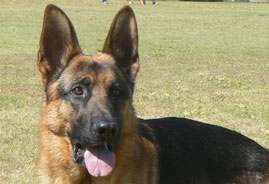Related sites with
loads of relavent and quality information:
|
Training
the Pause Table - Part 4
The Secure
Agility Stay
By MS du Toit
The
agility stay differs somewhat from the obedience stay. In the obedience
stay you always return to your dog before the exercise is finished. In
agility the stay is broken the moment you give a release command, and that
can be from anywhere on the course. The release command can be any word
or phrase you choose, but as with all commands, should be used
consistently. Normally, while the dog is on the table, you will
position yourself at the next obstacle. If you also want to take part
in obedience competitions, I suggest you use two different commands for
the two different stays, so the dog does not get confused.
The agility stay is not just performed on the table, but can also be
performed at the start line, although it is not necessary. The reason I
mention this is to emphasize the fact that you should not just expect
and train your dog to stay for five seconds. You might want him to stay
much longer than five counts at the start line, while you position
yourself on the course. Always vary the duration of the stay during
training sessions even up to two to five minutes. You really need a
solid stay from your dog.
It is especially important that you do not try to progress too fast
with this command. You need to set your dog up for success. If you
increase the duration of the stay or the distance away from your dog
too fast, your dog will break his stay, and that can very easily become
a habit. It is very important that you do not take your eye off of your
dog, not even for one second.
When you start to train the agility stay, you should approach it
exactly the same as you would the obedience stay. Put your dog in
either the sit or down position. Give the stay command and give one
step away. Immediately step back and click and treat.
Break the stay. Repeat the exercise many times before you increase the
duration with only a few seconds. While increasing the duration, keep
the distance from the dog constant. I would strongly suggest that you
first increase the duration and with the distance constant, and not the
other way around.
Once you get a reliable stay from your dog for about two minutes, you
can also, in a separate training session, start increasing the distance
from the dog. You do that by just moving away a few more steps and
immediately returning to your dog. With this further distance from your
dog, you now again start to work on the duration for that distance. You
repeat the whole procedure again every time you increase the distance.
You now have a very reliable stay from your dog. But what will happen
if you put him in a stay, and you run away from him? I ask that
question, because that is exactly what is going to happen on a course.
On the course everything happens fast, and while the judge counts to
five, you want to position yourself at the next obstacle and be ready.
Therefor you need to train your dog to stay even when you run away from
him. You train him to do that by just moving away faster every time,
and only a few steps at first, repeating the stay command as you move
away. Also keep your hand outstretched towards your dog with your palm
facing your dog. This is a very strong stay hand signal. Repeat this
exercise, ever increasing the distance one step at a time until you can
run away for about 50 meters with your dog still in his stay position.
If he breaks his stay, you progressed too fast.
MS du Toit has been training dogs for ten years.
Please visit her Dog
Training Review Page.
Back to Top
Continue to Part 5 of the series: Training
the release
Back to Part 3: Fast sit or down
Back to Articles
|
|

